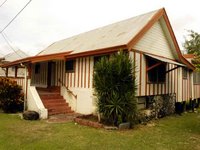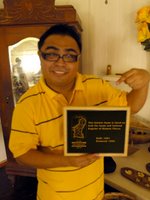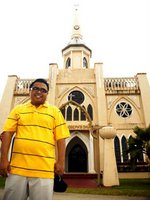 Today we visited the southern end of Guam. It was raining since the tip of a storm was passing through Guam. After breakfast at the hotel, we made our way eastward towards the Pacific side of the island. We stopped by the Mangilao Golf Club to check out the view of the Pacific coast and take some photos. Notice the hand gesture? That's the sign for Hafa Adai which is Chamorro for hello.
Today we visited the southern end of Guam. It was raining since the tip of a storm was passing through Guam. After breakfast at the hotel, we made our way eastward towards the Pacific side of the island. We stopped by the Mangilao Golf Club to check out the view of the Pacific coast and take some photos. Notice the hand gesture? That's the sign for Hafa Adai which is Chamorro for hello. From Mangilao, it was a southward drive towards Talofofo. But on the way, we checked out the jungle cruise port but the boat had just left. There are two schedules, one at 9 a.m. and another at 1 p.m.
From Mangilao, it was a southward drive towards Talofofo. But on the way, we checked out the jungle cruise port but the boat had just left. There are two schedules, one at 9 a.m. and another at 1 p.m.Our next stop was the Talofofo Falls Park. Talofofo Falls is one of Guam's popular tourist attractions. A privately owned area, the entrance fee for tourists is US$20 which includes a two-minute cable car ride down to the falls and back, the amusement park, and a visit to Yokai Cave.
 The cave was the hiding place of Sergeant Soichi Yokoi, a Japanese soldier who hid in the Talofofo jungles for 28 years following the defeat of the Japanese in World War II. He was finally captured in 1972 and returned to Japan where he was given his back-pay. From the depiction on the wall, you could see that the cave was actually a small bunker 2.5 meters below the ground, 1 meter high and 1.5 meters wide.
The cave was the hiding place of Sergeant Soichi Yokoi, a Japanese soldier who hid in the Talofofo jungles for 28 years following the defeat of the Japanese in World War II. He was finally captured in 1972 and returned to Japan where he was given his back-pay. From the depiction on the wall, you could see that the cave was actually a small bunker 2.5 meters below the ground, 1 meter high and 1.5 meters wide. We took the cable car down to the waterfalls area and hiked around. There are actually two waterfalls. Several rope bridges allow visitors to walk across the river to get around the falls area.
We took the cable car down to the waterfalls area and hiked around. There are actually two waterfalls. Several rope bridges allow visitors to walk across the river to get around the falls area. From Talofofo, we passed by Inarajan which we visited yesterday. We stopped at the Saluglula Pool which was a popular swimming area with a two-meter deep natural pool popular for diving. This pool was protected from the strong waves by several rocks.
From Talofofo, we passed by Inarajan which we visited yesterday. We stopped at the Saluglula Pool which was a popular swimming area with a two-meter deep natural pool popular for diving. This pool was protected from the strong waves by several rocks.We made our way to Merizo which was celebrating its village fiesta that day, known as Fiestan Tasi. Among the interesting sites in the village is an old convent which is now a school as well as a bell tower. There is also a replica of the image of the Our Lady of Camarin, the patroness of Guam, right in front of the church plaza. Merizo Port is also the jump off point for Cocos Island, a very popular beach among Japanese tourists.
 From Merizo, we went to Fort Nuestra Senora de la Soledad in the village of Umatac. Umatac Bay is said to be the landing site of Ferdinand Magellan in 1521 which is why a monument to him could also be found in the village. In 1565, Miguel Lopez de Legazpi arrived in Umatac, claiming the islands for Spain. This would start the long intertwined history of the Philippines and Guam since the Marianas were governed by the governor-general in Manila.
From Merizo, we went to Fort Nuestra Senora de la Soledad in the village of Umatac. Umatac Bay is said to be the landing site of Ferdinand Magellan in 1521 which is why a monument to him could also be found in the village. In 1565, Miguel Lopez de Legazpi arrived in Umatac, claiming the islands for Spain. This would start the long intertwined history of the Philippines and Guam since the Marianas were governed by the governor-general in Manila. Umatac Bay was very important to the Manila Galleon Trade since it was the last replenishment stop before the long voyage to Acapulco in Mexico. Which is why from 1680 to 1810, several fortifications were built to protect the galleons from pirates and privateers. The last of the four forts constructed was Fort Soledad.
Umatac Bay was very important to the Manila Galleon Trade since it was the last replenishment stop before the long voyage to Acapulco in Mexico. Which is why from 1680 to 1810, several fortifications were built to protect the galleons from pirates and privateers. The last of the four forts constructed was Fort Soledad.It was already close to 2 p.m. and we realized we hadn't had lunch yet. So our driver took us to a popular Filipino restaurant in Tamuning which is actually an institution in the Filipino community of Guam. Opening its doors in 1987, Rambie’s is said to be the longest-running Filipino restaurants in Guam. Serving Pinoy favorites such as kare-kare, sinigang, caldereta and dinuguan, the restaurant uses the turo-turo concept, enticing customers with its colorful display of different dishes.
From Rambie's, we made our way to the Hyatt in Tumon to pick up the Probe crew who had done interviews the whole day. From there, we went back to the hotel to freshen up for a dinner cruise. But the sad part was the boat cruise cancelled due to the storm. So we decided to go shopping.
Our first stop was Micronesia Mall which is owned by none other than Lucio Tan. I guess the Philippines is completing its invasion of Guam with the arrival of shopping malls. Yes, Henry Sy has his own stake on the island as well. Jollibee is there too and so is San Miguel! After Micronesia Mall which closes at 6 p.m. on Sundays would you believe, we went to K-Mart which was open 24 hours. Anyway, more tomorrow.
Heritage updates
626-year-old mosque named National Shrine

















